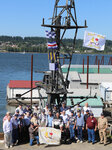





When John Bailey, now 78, was serving aboard the USS Nicholas DD-449 as a drone anti-submarine helicopter (DASH) operator for the U.S. Navy during the Vietnam War, he thought the World War II era ship was a “rust bucket” despite having been refurbished and modernized in the 1960s.
Decades later, Bailey is now working with the USS Nicholas Veterans Association to preserve one of the last remaining pieces of the now decommissioned and salvaged ship — the top third section of the Nicholas’ mast, which is approximately 50 feet tall.
In modern ships, the mast is used to display identifying and maritime signal flags and also holds various radar and communication systems.
He is currently working with a local contractor to pour a flood-proof concrete foundation complete with memorial plaques for both the Nicholas and its sister ship, the USS O’Bannon, DD-450, outside of the Veterans Memorial Museum in Chehalis.
“We’ll be celebrating both ships here with this one particular mast,” Bailey said.
He hopes to have the foundation and memorial base completed and the mast standing upright within a couple weeks.
“The museum has the (Rust or Shine) car show on the third, so we’re probably gonna run through the car show and be here in the days following, but we’re trying our best to get this guy out of the way before the car show,” Bailey said.
The efforts to save the mast and get it on display have been ongoing for nearly three years.
Both the O’Bannon and Nicholas are Fletcher class destroyers that were built side by side by Bath Iron Works in Maine and put to sea in 1942. They were some of the first of a total of 175 Fletcher class destroyers built during WWII.
“They are unique in Navy history as far as I know. The two of them have been drawn into things together. They’ve always been the same destroyer squadron,” Bailey said. “They’ve been in the same action. When they were mothballed with 100 other destroyers, they were mothballed right next to each other. They were pulled out of mothballed and recommissioned side by side, and they’re both named after Marines.”
The Nicholas was named after Major Samuel Nicholas, the first commandant of the Marine Corps during the Revolutionary War, and the O’Bannon was named after First Lieutenant Presley O’Bannon, whose exploits are immortalized in the Marine Corps hymn with the line, “to the shores of Tripoli.”
The Nicholas’ bell is currently housed at the Center House Marine barracks in Washington, D.C., home to the Marine Corps silent drill platoon among other units. Together with the mast, those are the last remaining pieces of the Nicholas. Bailey is planning on having a replica bell cast for the mast memorial at the museum.
Both ships were involved in numerous battles during the island-hopping campaign in the Solomon Islands and Guadalcanal as a part of Admiral William Halsey’s fleet during WWII. The ships both earned the Presidential Unit Citation, according to Bailey, and the O’Bannon also earned 17 battle stars during WWII, the most of any destroyer.
He added it was rumored Admiral Chester Nimitz viewed the Nicholas as his favorite ship, and Halsey was known to love the O’Bannon.
“In our monument here, when we get the brass plaques in place, the plaque for the Nicholas is basically a quote from Admiral Nimitz, and the plaque for the O’Bannon is basically a quote from Admiral Halsey, about what they thought about these two ships,” Bailey said.
Nimitz held all 175 Fletcher class destroyers in high regard, as evidenced by his Jan. 28, 1944, speech during the Nicholas’ Presidential Unit Citation award ceremony.
“Our destroyers have truly been the silent part of our service, but their exploits and their capabilities are well known to those who have to know. Congratulations from the Pacific Fleet to every officer and man of Nicholas. Well done,” Nimitz said.
After the Japanese surrendered in August of 1945, the Nicholas was given the honor of being the lead destroyer escorting the USS Missouri into Tokyo Bay for the signing of surrender documents.
Bailey and his fellow veterans rescued the top section of the Nicholas’ mast from where it was displayed at the Portland Sea Scout base along a frontage road near the Portland International Airport.
In 2020, the Sea Scouts were told by the Airport Authority the mast needed to go, so they reached out to the USS Nicholas Veterans Association and asked if they wanted the mast.
“We came and got it, cut it into three pieces, moved it up here to the museum and we got it welded back together,” Bailey said.
Due to local ordinances and flood risk mitigation, it has taken a couple of years to get the memorial’s design plans approved, but groundbreaking finally happened last weekemd.
Aside from his work at the museum helping preserve the Nicholas’ mast, Bailey and his wife tour the country interviewing other veterans who served on the Nicholas.
For more information and to get into contact with Bailey, visit http://www.sisterships.us/.
The Veterans Memorial Museum is located at 100 SW Veterans Way in Chehalis. For more information, visit https://www.veteransmuseum.org/.